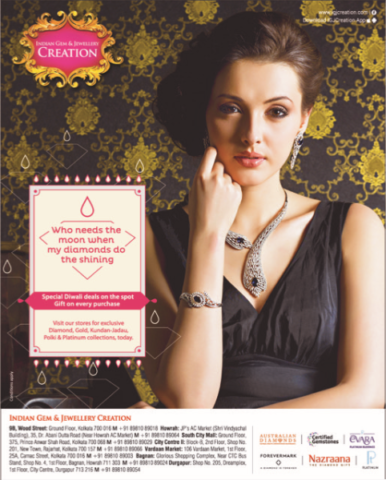Legend has it that the son of King Hima was cursed to die, bitten by a snake as he slept, on the fourth day of his marriage. His young wife, determined to break the jinx, is said to have strewn her ornaments all around his bed, lighting up the night with a million lamps and blocking the entrance to the room with a heap of gold and silver coins. Going further, she had kept him awake the whole night telling him stories and singing songs.

Lord Yama, the king of Death, who had gone in the guise of a snake to take the life of the young prince was stunned by the dazzle of the lights and the precious metals, listening to the pious wife mesmerised. The prince was kept awake all night and when the day broke, Lord Yama was forced to bless the young queen for her resolve and the ability to conquer fate, before slithering away.
It is this desire of women everywhere – the desire to take on death itself for the well being of their husbands – is celebrated as Dhanteras. A victory that is celebrated the following day as traditionally, women decorate their homes and hearths with lamps, in what is known as the Naraka Chaturdashi (Naraka = Hell, Chaturdashi = the fourteenth day). The jewellery that the women adorn themselves with is aimed at dazzling the Lord of Death, the tradition of buying precious metals a means towards staving off, even the inevitable, with the lustre of the lucre. On a more basic level, the virtue of hoarding precious metals as a wherewithal to fight the negativities of life being the central message that the festival seeks to convey.
Popular belief however, relates the festivities of Dhanteras to even more ancient times. It is said that when the oceans were churned, the Goddess Lakshmi had appeared bearing nectar in her hands – an event that is celebrated as Dhanteras on the holy day of Trayodashi (thirteenth day of the Krishna pakshya of the Samvat calendar month of Ashwin). According to this tradition, Lord Kuber (the God of Wealth) is also venerated on the auspicious day which explains the practise of buying precious metals to mark the occasion.
According to another widely held belief, Dhanteras is actually Dhanwantari Trayodoshi, when Dhanwantari – the teacher of all physicians and from whom flows the ancient medical wisdom of Ayurveda – is revered. Naturally, it is a celebration of health, as opposed to wealth, though perhaps, the terms are used interchangeably.

Whatever be the origin of the festival, there is no denying the fact that over time, it has emerged as one of the most celebrated among all the festivities that mark the Indian calendar. On this auspicious occasion, India lights up as innumerable lamps illuminate to caste the evil portends away. The ladies of the house coiffeur themselves, in a celebration that is as much about the purity of their ornaments as it is of the intrinsic value of what is worn. It is also an occasion to buy precious metals – gold, silver, platinum and ornaments created out of them in what is essentially an acknowledgement of the Indian tradition of savings, of the accumulation of wealth as a means of a prayer to the Goddess Lakshmi. On another level, Dhanteras is widely hailed as one that performs an economic function of immense importance – collecting the scattered savings of the household and converting them into wealth, ready for deployment.
Metal Utensils are also bought on this auspicious day as a mark of reverence to the family ties, to seek divine blessings for the household. The homes are decorated, often with Rangoli’s ready for the Goddess of Wealth to step in with her blessings, in what is a uniquely Indian tradition cutting across all barriers of caste, creed, colour or religion where family ties are venerated, savings encouraged and prosperity revered. A festival, where the preciousness of the ornaments and the metals that are acquired and worn are matched by the purity of the souls that wear them and sacred means that are used to acquire them. Dhanteras is therefore, also the sacred Muhurat, when the traditional books of accounts are formally opened.
At IJGC it has been our good fortune to share your happy moments for the last 150 years. This Dhanteras, join us as we spread the precious Naivedya for you to welcome the Goddess to your homes, hearths and hearts.

Pramod Dugar is Kolkata’s most revered jeweller, an exponent of the fine art of the blending of precious metals with gems to craft jewellery pieces that test time. His name is synonymous with the landmark called the Indian Gem & jewellery creation which is now witnessing the involvement of the nineth generation through Prateej and Prayas Dugar even as it continues to straddle the imagination wit exquisite creation in and with gold, platinum, diamonds, kundan-jadau and precious gemstones. The company has its flagship store in 9b, Wood Street, apart from showrooms in Howrah, SouthCity Mall, City Centre II, Vardaan market, Bagnan and Durgapur.
